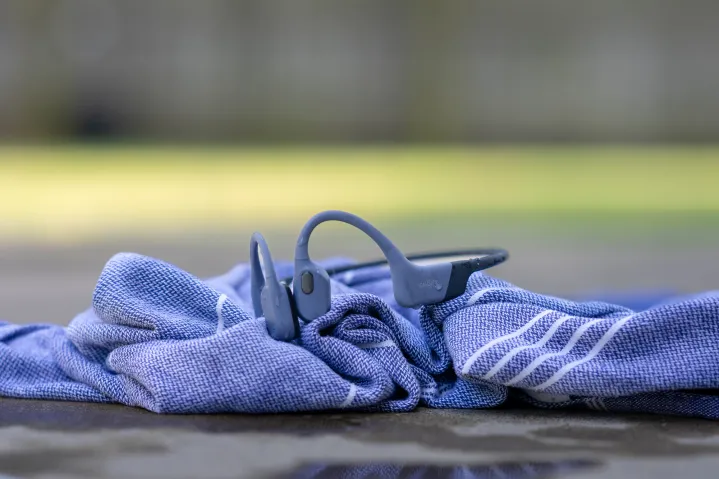- Perform great when swimming
- Bluetooth adds missing functionality
- Comfortable fit
- Stay secure while exercising
- Audio quality isn't great out of the water
- Niche, not everyday headphones
For the unfamiliar, let’s just get this out of the way: Yes, the Shokz OpenSwim Pro are headphones to use while swimming. For the slightly more familiar: These are bone-conduction headphones that are great for being used in water.
And for those who already spend plenty of time doing laps and own the original OpenSwim and want to know what this “Pro” business is all about? These upgrades mean you can now stream audio from your usual streaming music or podcast app while you’re out of the water.
That’s the short version. Here comes the long version.
What’s new
The OpenSwim Pro (which launched at the same time as the OpenFit Air) build on the original OpenSwim. And as the name implies, they’re still meant to be used while swimming. They keep the same around-the-head design (which makes sense because you still want that extra stability), but they’ve gained a world of functionality.

See, Bluetooth headphones don’t really work in water. Because water. So the original OpenSwim were limited to just playing back local music files. If you’re of a certain age, you’ll recall that in the era before the streaming music apps, we had to rip CDs and manage our own music files locally on our computers. In folders. (And we absolutely worried about things like copyright, nudge nudge, wink wink.) The first iPods were basically the same, too.

Nowadays, using MP3 files is a fairly rare thing. But if you want to use the OpenSwim line as designed, in water, it’s what you’ll have to do. The only hard part is actually finding legal music files to download and move around as you see fit. It’s not impossible — just not something you can do on Spotify or Apple Music, ya know? But once you have your files, it’s just a matter of plugging the OpenSwim Pro into a computer, where they’re recognized like any other external drive. Copy over your music, select Swim mode in the Shokz app or via the button on the headphones, and you’re good to go.
New this time is an old feature called Bluetooth that wasn’t available in the original OpenSwim. So now you can flip back and forth whether you’re in the pool or on dry land. There’s a toggle in the app for that, and you can assign that to a button on the OpenSwim Pro. (And they’ll also sync to two devices at once via Bluetooth multipoint, if that’s important to you.)
Not to put too fine a point on it, but we’ll put the functionality in bullet points here so there’s no confusion:
- Bluetooth playback: For use when you’re not swimming, just like any other headphones.
- MP3 playback: For local files that you’ve copied to the OpenSwim Pro, for when you’re in the water.
Time to get wet
The idea of listening to music while swimming is still pretty novel to me — I’m not a laps kind of guy. But I definitely understand wanting to have something to listen to while you’re doing one length of the pool after another.

Before you get in the water, you’ll probably note that the audio coming out of these things isn’t all that great. There’s not a ton of bass whether you’re streaming things with Bluetooth or if you flip over to the local mode for swimming. That’s fairly standard for this sort of bone-conduction device — everything’s pretty tinny. And generally speaking, I’m OK with that because I’m probably going to be using these while I’m exercising. If audio quality is that important, check out the Shokz OpenFit instead.

But water is a magical thing. Once you’ve got your face pointed at the surface and the sound starts to flow through that H20 — and remember to flip over to local music playback first — you’re suddenly greeted by a surprising amount of bass. Water transmits sound more quickly than air, of course. But I was pleasantly surprised at how well the OpenSwim Pro are tuned for use while swimming. Maybe that shouldn’t be a surprise — that’s what they’re meant for, after all. But the end result was astonishingly good.
The functionality, by the way, is buoyed by an IP68 waterproof rating that should keep things safe up to 2 meters for two hours. The mics also have a “breathable” membrane that should keep you understandable, but the fine print still warns that weirdness may happen at some point, because we’re still dealing with electronics and water.
The app, and other things …
Controls on the OpenSwim Pro are pretty much identical to those of other bone-conduction options that came before them. There’s a large button on the left-hand pod that sits just above your ear, and two buttons on the right-hand stem that sits below your ear. Those buttons serve as combination power/volume buttons. But note that the controls are customizable in the Shokz app. The large button on the left can trigger a voice assistant or switch from Bluetooth to MP3 mode, and the same can be done with the buttons on the right, configured as a long press of both of them together. (Individually, they serve as power and volume.)

There’s no mechanism to skip forward or back, so you’ll need to do a little preplanning as far as playlists are concerned. That’s even more true when it comes to MP3 playback mode — it’s sort of like the bad old days when we’d burn MP3 CDs to use in cars. MP3 mode does allow you to choose between “normal” or straight-through playback, shuffle, or repeat.
You don’t get much in the way of EQ options, but the app is where you can flip between music or vocals in Bluetooth mode, and standard or swimming EQ modes for MP3 playback. However, if EQ is a big deal to you and you want to improve the sound as much as possible, in Bluetooth mode, if your streaming app has built-in EQ adjustment capabilities (Spotify, Apple Music, and Amazon Music do, for example), you can improve things somewhat.
Battery life is rated at 9 hours in Bluetooth mode, and 6 hours in local MP3 mode. Both of those should be more than adequate, and 10 minutes on the magnetic charger should get you about three more hours of playback.
Other tech specs of note: There’s 32GB of onboard storage for all those MP3s, which is kind of a ridiculous amount. (Shokz puts it at about 8,000 4MB files.) And you’ll be using Bluetooth 5.4 on that side of things.

Should you buy them?
If you haven’t figured it out by now, the Shokz OpenSwim Pro are niche headphones. They’re absolutely the sort of thing I’d buy if I were to spend hours doing laps in a pool. Or if I were a triathlete. I do neither of those things.
They’ll do exactly what they say they’ll do, and they do it well. They’re not everyday headphones.
But that niche status also means a higher price at $180. These won’t be for casual swimmers, but then again, they’re not supposed to be.





